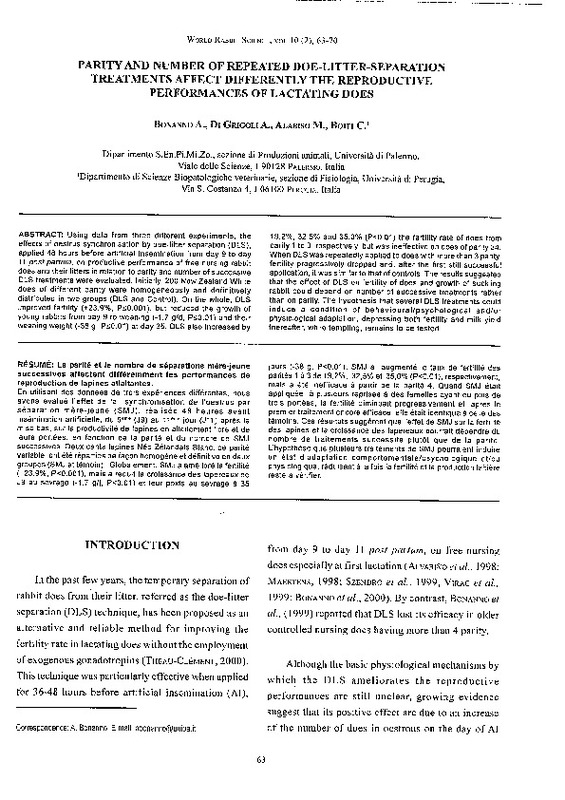JavaScript is disabled for your browser. Some features of this site may not work without it.
Buscar en RiuNet
Listar
Mi cuenta
Estadísticas
Ayuda RiuNet
Admin. UPV
PARITY AND NUMBER OF REPEATED DOE-LITTER-SEPARATION TREATMENTS AFFECT DIFFERENTLY THE REPRODUCTIVE PERFORMANCES OF LACTATING DOES
Mostrar el registro sencillo del ítem
Ficheros en el ítem
| dc.contributor.author | Bonanno, A.
|
|
| dc.contributor.author | Di Grigoli, A.
|
|
| dc.contributor.author | Alabiso, M.
|
|
| dc.contributor.author | Boiti, C.
|
|
| dc.date.accessioned | 2011-02-24T13:33:48Z | |
| dc.date.available | 2011-02-24T13:33:48Z | |
| dc.date.issued | 2002 | |
| dc.identifier.issn | 1257-5011 | |
| dc.identifier.uri | http://hdl.handle.net/10251/10004 | |
| dc.description.abstract | [EN] Using data from three different experiments, the effects of oestrus synchronisation by doe-litter separation (DLS), applied 48 hours befare artificial insemination from day 9 to day 11 post partum, on productive performance of free nursing rabbit does and their litters in relation to parity and number of successive DLS treatments were evaluated. lnitially, 200 New Zealand White does of different parity were homogeneously and definitively distributed in two groups (DLS and Control). On the whole, DLS improved fertility (+23.9%, Ps0.001 ), but reduced the growth of young rabbits from day 9 to weaning (-1.7 g/d, Ps0.01) and their weaning weight (-38 g, Ps0.01) at day 35. DLS also increased by 19.2%, 32.5% and 35.0% (Ps0.01) the fertility rate of does from parity 1 to 3, respectively. but was ineffective on does of parity <:4. When DLS was repeatedly applied to does with more than 3 parity, fertility progressively dropped and, after the first still successful application, it was similar to !ha! of controls. The results suggested that the effect of DLS on fertility of does and growth of suckling rabbit could depend on number of successive treatments rather !han on parity. The hypothesis !ha! severa! DLS treatments could induce a condi!ion of behavioural/psychological and/or physiological adaptation, depressing both fertility and milk yield thereafter, while tempting, remains to be tested. | es_ES |
| dc.description.abstract | [FR] En utilisant des données de trois expériences différentes, nous avons évalué J'effet de la synchronisation de l'oestrus par séparation mere-jeune (SMJ), réalisée 48 heures avant insémination artificielle, du 9eme (J9) au 11 eme jour (J11) apres la mise bas, sur la productivité de lapines en allaitement libre et de leurs portées, en fonction de la parité et du nombre de SMJ successives. Deux cents lapines Néo Zélandais Blanc, de parité variable, ont été réparties de fa9on homogene et définitive en deux groupes (SMJ et témoin). Globalement, SMJ a amélioré Ja fertilité (+23.9%, P<0.001 ), mais a réduit la croissance des Japereaux de J9 au sevrage (-1, 7 g/j, P<0.01) et leur poids au sevrage a 35 jours (-38 g, P<0.01 ). SMJ a augmenté le taux de fertilité des parités 1 a 3 de 19,2%, 32,5% et 35,0% (P<0.01 ), respectivement, mais a été inefficace a partir de la parité 4. Quand SMJ était appliquée a plusieurs reprises a des femelles ayant ·eu plus de trois portées, la fertilité diminuait progressivement et, apres le premier traitement encare efficace, elle é!ait identique a celle des témoins. Ces résultats suggerent que J'effet de SMJ sur la fertilité des lapines et la croissance des Japereaux pourrait dépendre du nombre de traitements successifs plutot que de la parité. L'hypothese que plusieurs traitements de SMJ pourraient induire un état d'adaptation comportementale/psychologique et/ou physiologique, réduisant a la fois la fertilité et la production laitiere reste a vérifier. | |
| dc.description.sponsorship | This work was supported by a grant from "Ministero per l'Istruzione, l'Università e la Ricerca" | |
| dc.language | Inglés | es_ES |
| dc.publisher | World Rabbit Science. ICTA. UPV | es_ES |
| dc.relation.ispartof | World Rabbit Science | |
| dc.rights | Reserva de todos los derechos | es_ES |
| dc.title | PARITY AND NUMBER OF REPEATED DOE-LITTER-SEPARATION TREATMENTS AFFECT DIFFERENTLY THE REPRODUCTIVE PERFORMANCES OF LACTATING DOES | es_ES |
| dc.type | Artículo | es_ES |
| dc.date.updated | 2011-02-24T13:28:32Z | |
| dc.identifier.doi | 10.4995/wrs.2002.477 | |
| dc.rights.accessRights | Abierto | es_ES |
| dc.description.bibliographicCitation | Bonanno, A.; Di Grigoli, A.; Alabiso, M.; Boiti, C. (2002). PARITY AND NUMBER OF REPEATED DOE-LITTER-SEPARATION TREATMENTS AFFECT DIFFERENTLY THE REPRODUCTIVE PERFORMANCES OF LACTATING DOES. World Rabbit Science. 10(2). https://doi.org/10.4995/wrs.2002.477 | es_ES |
| dc.description.accrualMethod | SWORD | es_ES |
| dc.relation.publisherversion | https://doi.org/10.4995/wrs.2002.477 | |
| dc.description.volume | 10 | |
| dc.description.issue | 2 | |
| dc.identifier.eissn | 1989-8886 | es_ES |
| dc.contributor.funder | Ministero dell'Istruzione dell'Università e della Ricerca, Italia |








